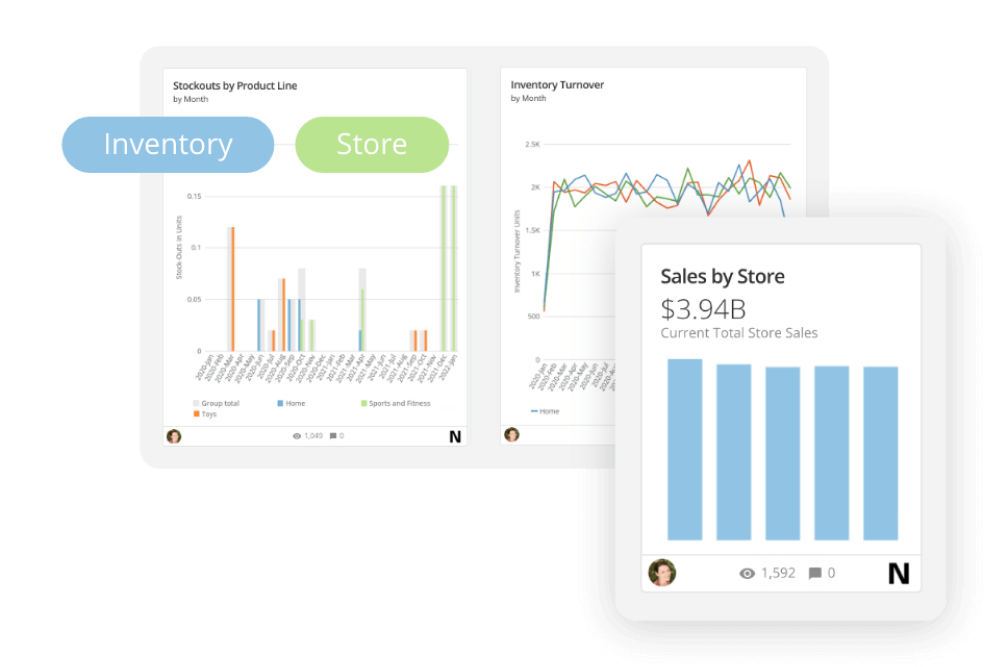How business intelligence helps retail businesses improve customer experience
In every facet of business–and of society as a whole–we’re using data and technology more and more to streamline processes, improve experiences and increase efficiency.
Despite this, an aspect of retail business operations that is lagging noticeably behind is the management of customer experience, which still largely depends on customer surveys and the compilation of survey data to discern the quality of the customer’s experience with a brand.
However, these surveys rarely represent more than a small proportion of customers, take a long time to carry out, compile and analyze, and only provide insight into certain aspects of their retail customer experience.
This is where business intelligence (BI) can help, as a way to gain critical insight into the customer experience and to point to areas of potential improvement that businesses can instantly act upon.

What is business intelligence (BI)?
Business intelligence (BI) is defined as “the applications, infrastructure and tools, and best practices that enable access to – and analysis – of information to improve and optimize decisions and performance” according to Gartner, the technological research and consulting firm.
These decisions, described by Gartner, are data-driven, leaving human bias out of the decision making process.
For the improvement of the customer experience, the most crucial of these technologies are:
Data sources – these include data-generating devices, softwares and apps, your CRM, e-commerce platform and POS system, in addition to spreadsheets, databases and files that relate to customer experience.
Data connectors– a service able to connect all the sources of data the business has relating to customer experience into a singular location, such as a data warehouse or lake.
Dashboards –interactive visualizations of CX data, including stats, charts and graphs that allow patterns and trends in data to be identified, and enable data to be ‘drilled down’ for greater insight.
With business intelligence tools, the data is able to illustrate how positively your customers perceive the experience of interacting with your brand, and where the customer experience could be improved, identifying ‘pain points’ along the customer journey.
This makes BI incredibly useful in improving the customer experience, as you can make–and see–improvements to the customer experience in real time.
Why is customer experience (CX) so important?
Customer experience (CX) is, as the name itself explains, the experience that customer has when interacting with your brand, consisting of everything that has an effect on the perception and feelings they associate with your brand.
By providing a great CX to their customers, businesses increase the positive associations they have with your brand, encouraging them to interact with your business again, reducing customer churn and boosting sales.
This is particularly important as, in the world of business, it’s more beneficial and cost-effective for businesses to be able to keep pre-existing customers than it is to attract and convert new leads.
More than this, satisfied customers who had a particularly positive experience with your company are more likely to talk about your brand positively to other potential customers, whether online or offline, which can increase the number of leads that are eager to interact with your business.
In fact, the Word of Mouth Marketing Association and the American Marketing Association conducted a survey into the effectiveness of such marketing and found that 64% of marketing executives believed word of mouth marketing was the most effective form of marketing.
So, not only can providing your customers with a positive CX reduce the likelihood of those customers terminating their relationship with your business, but it can also provide marketing for your business in a way that’s not just incredibly effective–it’s free.
Therefore, a positive CX can boost revenue, reduce customer churn–and the associated expenses that come with replacing those customers with new ones–and improve brand trust and loyalty.
On the other hand, customers who have a negative experience with your brand can have the opposite effect, terminating their relationship with your business and deterring others from first engaging with your brand–so providing a negative CX should be avoided at all costs.

How can business intelligence solutions improve the customer experience?
There are numerous possibilities, expanded by seemingly unlimited integration opportunities, for the ways that business intelligence can help to improve the retail customer experience.
Here are the top 8.
1. BI solutions indicate areas of improvement
By displaying data visually in an easy-to-digest graphical format, patterns and trends can easily be identified, showing where along the customer journey most customers are experiencing difficulty, allowing your brand to target and improve these areas more effectively.
When powered with AI and machine learning capabilities, customer experience dashboards are able to perform “clustering” which allows common topics to be identified among the wider customer rhetoric, to allow you to see where your customers have a positive perception of the experience and what they most commonly complain about.
More than this, by integrating with applications such as sentiment analysis APIs–which engage in natural language processing and text analysis to extract meaning from text, determining the overall opinions of customers from this analysis–businesses can gauge the overall feelings and opinions of customers about their brand.
In contrast to pointing to specific pain points on the customer journey, this can help brands understand how they’re perceived overall. They can also better detect if there is a universal sentiment held about the entire customer experience that might otherwise be missed when focusing on specific aspects of the customer journey.
2. BI solutions display data in real-time
Compared to more archaic methods of assessing and analyzing customer experience, BI solutions display data in real-time, so each data-driven decision made to improve the customer experience will be even more relevant, since they’re informed by data retrieved right at that moment.
3. BI can stop negative CX experiences in real-time
By integrating with social listening tools–which allow businesses to monitor how their brand is being talked about on social media–BI solutions can indicate when a customer is posting negatively about their ongoing experience with your brand on social media.
This enables your business to step in and offer help to the customer, which will hopefully reinstate the positive associations they have with your brand, improving brand loyalty, reducing customer churn and decreasing the likelihood that they will continue to badmouth your brand online.
4. BI solutions make it easy to share findings
With the use of dashboards, BI solutions make findings from data easy to understand which, in turn, makes these findings easy to act upon.
In addition to being useful in just one department, this makes it easier to share knowledge between departments so that each is kept informed of CX performance and can make adjustments where necessary to improve the customer experience as a whole.
This can help to prevent silos between departments, which can unify and work together towards creating a better customer experience.
5. BI solutions are time-efficient
Compared to manually compiling and analyzing data from a ton of different sources, business intelligence solutions allow data to be instantly compiled and displayed in easy-to-understand visualizations.
Not only does this free up the time of your employees to complete higher value tasks–rather than sifting through different data sources and applications to gauge customer experience–but it allows decisions to be made more quickly as the data is arranged in a way that makes it simple and quick to interpret, so that you can improve your retail customer experience even faster.
6. BI solutions offer omni-channel insight
Since BI solutions collect and display data from numerous sources, a business is able to gain omni-channel insight into the customer experience by connecting to data from social media listening tools, customer surveys, direct interactions between the customer and business–including complaints, resolution, and more.
This allows businesses to gain an overview that includes every type of customer experience from every channel possible.
7. BI solutions enable CX predictions to be made
As business intelligence solutions provide access to both present and historical data, trends and patterns over time can easily be identified.
Not only does this allow you to see whether improvements you’ve made to the customer experience have worked, but it can enable you to make predictions about the future.
For example, if there is a pattern of data that shows a decline in customer experience after a particular event has taken place, then you can predict that, when a similar event happens in the future, customer experience is likely to be similarly impacted.
This can help businesses to prepare against future events that could cause a decline in the quality of customer experience, to ensure that a high quality CX is maintained.
Conclusion
Customer experience continues to be a focal point for retail businesses of all sizes and types. Ensuring your customers have the best experience possible is critical to winning their business again and again. BI tools can help you leverage your data to better understand your customer segments. Through data analytics, you can provide continuous improvement to your retail business.
